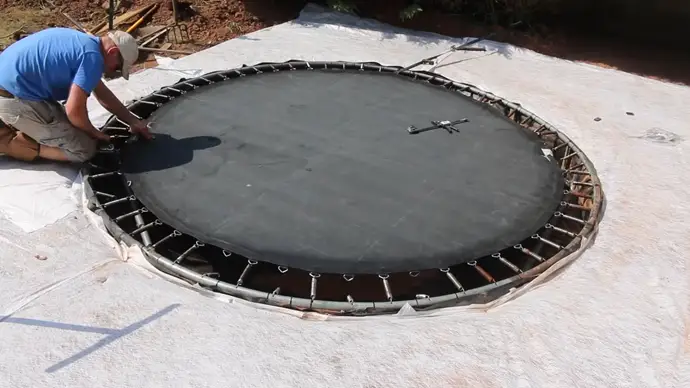Trampolines offer hours of entertainment for children and adults and several health benefits. Still, whenever you have a normal trampoline, there is always the risk of injury. To ensure your children’s safety, it may be a good idea to convert your regular trampoline into an in-ground trampoline.
But can you put a normal trampoline on the ground for kids’ safety? Bouncing on an in-ground trampoline can be a safe way to relieve stress and tension since there is no risk of falling. Further, it is a very effective exercise for your legs and core muscles.
Hence, placing a trampoline on the ground has some advantages. To avoid the additional hassle, you should identify the proper location for placing a trampoline on the ground. Learn how to set up a trampoline on the ground and how to maintain one.
Can I Embed a Regular Trampoline into the Ground?
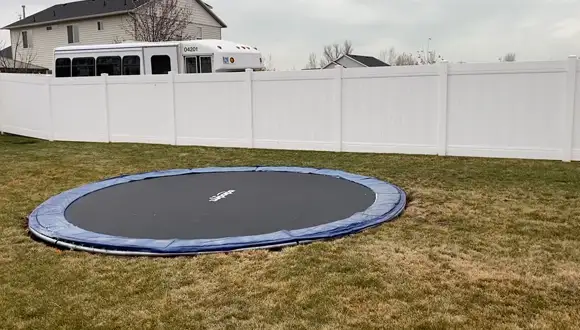
Trampolines are a great way to exercise, have fun, and entertain the kids, but if you’ve ever seen a trampoline left out in the rain, you know it can be an eyesore. One way to solve this problem is to embed the trampoline into the ground.
Doing so will give the trampoline a more finished look and make it less likely to blow away in strong winds. But there are a few things you need to keep in mind before you start:
- Make sure you choose a safe location that doesn’t flood frequently.
- You must dig a trampoline hole that’s wide and deep enough to accommodate the entire trampoline.
- Use anchoring stakes and heavy-duty ties to secure the trampoline in place.
- Ensure adequate airflow under the trampoline when people jump.
With a little effort, you can transform an ordinary trampoline into a permanent backyard feature, providing hours of enjoyment for the entire family.
How Can You Put a Normal Trampoline in the Ground for Better Safety?
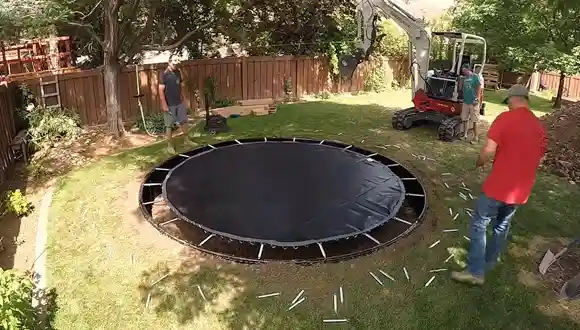
Typically, people think of trampolines as regular trampolines when they hear the word “trampoline.” These trampolines are supported by legs that raise them off the ground. Although trampolines with padding and nets have some safety features, they can still pose a risk to young children.
There are in-ground trampolines available for purchase, which are becoming increasingly popular because of their safety features. But if you’re wondering whether you can put your normal trampoline on the ground, the answer is yes. Doing so can provide better safeguards for kids while they’re playing.
A normal trampoline can be set up on the ground by following these steps:
Step 01. Clear the Installation Area
Before installing your in-ground trampoline, it’s essential to clear the installation area. This will help ensure your trampoline is stable and ground level. Start by removing boulders or debris from the area. Then, use a rake to level the ground and remove bumps or divots.
Clearing away debris, leveling the ground, and measuring the space to ensure the trampoline will fit. Once the area is cleared, you can start digging the hole for the trampoline.
Step 02. Become Familiar With Your Ground Soil
One crucial factor to consider when putting a trampoline on the ground is the type of soil in your area. Different types of soil have different drainage properties, which can impact the stability of the trampoline.
If you have soil that doesn’t drain well, you may need to install a sump pump or other drainage system to prevent the hole from filling with water. Knowing your area’s soil type is essential to ensure that your trampoline is stable and safe.
Step 03. Dig the Proper Hole
It’s essential to dig the proper hole for your trampoline. This will increase the stability of your rectangular or round trampoline and won’t topple over easily. Once you’ve found the perfect spot, use a tape measure to determine how deep the hole should be.
The general rule is that the hole should be about one foot deep for every three feet of trampoline length. So, for example, if your trampoline is nine feet wide, you’ll need to dig a hole three feet deep. Also, if you have a 9-foot trampoline length, you must dig a hole at least 10 feet in size. Ensure your trampoline sticks 8 to 12-inches above the hole for airflow.
Once you’ve determined the length & depth of the hole, use a shovel to start digging. Be sure to keep the hole walls straight so that the trampoline will fit snugly in place. Now, fill the bottom of the hole with a couple of inches of thicker sand before setting the trampoline. This will help to give it a sturdy foundation.
Step 04. Build the Retaining Wall and Install Drain
Most people choose to add a wall around the trampoline’s perimeter, keeping it separate from it so that the trampoline can be easily moved for maintenance purposes. Before you install a trampoline in the ground, you must build a foundation wall and install drains.
The first step is to excavate a trench around the perimeter of the trampoline. The trench should be 12 inches deep and 12 inches wide. Now, you need to install a drain pipe in the trench. The drain pipe should be perforated so water can drain away from the trampoline.
Once the drain pipe is in place, you must fill the trench with gravel. The gravel will help to prevent water from pooling around the trampoline.
Ultimately, you will need to build a retaining wall (such as the Sunken trampoline wall) around the perimeter of the trampoline. The retaining wall will help to support the trampoline and prevent it from moving during use.
Step 05. Set up the Trampoline
To set up a trampoline, you must first secure it to the ground. There are a few different ways to do this, but the most common is to use metal stakes. Drive the metal stakes into the ground around the perimeter of the trampoline, then loop the straps or springs around the stakes and secure them.
This will create a very sturdy base for the trampoline. Once the trampoline is secured, you can move on to set up. Follow the instructions with your particular trampoline model, but you will need to connect the frame components and then attach them to the jumping mat.
Add any additional safety features, such as padding under the trampoline. If necessary, you may need to fill in gaps behind the retaining wall with soil once everything has been installed.
Following these steps will ensure that your inground trampoline is safe and secure. You can easily install a trampoline on the ground to entertain the entire family.
Possible Consequences When Installing Regular Trampoline in the Ground
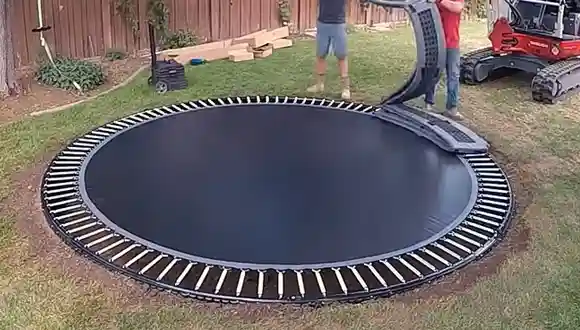
Some possible consequences come with installing a traditional trampoline on the ground. The Consequences could be:
Damage to Your Property With Terrible Hole
You could easily damage your property if you’re not careful when installing a ground trampoline. The most common way people damage their property is by not leveling the ground before they start the installation. This could lead to the legs of the trampoline sinking into the ground, making it hard to remove later on.
Also, if you don’t properly secure the trampoline, it could easily blow away, damaging anything in its path. Also, if you don’t leave enough space around the trampoline, you risk damaging the surrounding vegetation.
Improperly Installing a Ground Trampoline is a Safety Issue
Trampolines are already dangerous enough without adding extra risks. If the trampoline isn’t properly secured, it could easily topple over, injuring anyone nearby. Also, if there’s not enough space around the trampoline, someone could easily fall off and hurt themselves.
If the surface isn’t level, jumpers could quickly lose their balance and fall off the trampoline. The trampoline frame and springs can become dislodged, leading to entrapment or strangulation. An improperly installed trampoline can be an eyesore, and it can also make it difficult to mow your lawn or do other yard work.
Thus, parents should consult a professional before installing an inground trampoline and carefully follow all instructions to ensure the safest possible experience.
Pros and Cons of Putting a Regular Trampoline on the Ground
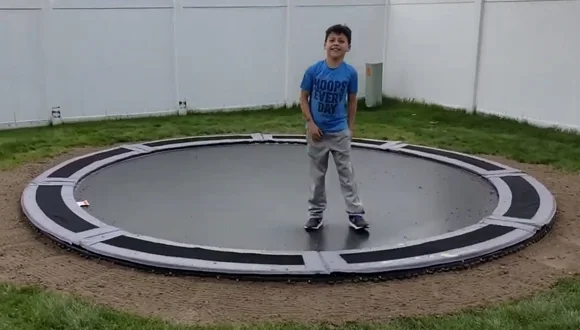
While inground trampolines can be a great source of exercise, they can also pose several dangers. Due to this, one must consider both the pros and cons of using a trampoline on the ground.
Pros of Inground Trampoline
Inground trampolines are a wonderful way to get some exercise and have many benefits that make them appealing to both kids and adults:
Safety: Unlike above-ground models, inground trampolines are flush with the ground, providing a softer landing surface if kids fall off, and the sides are lower, so it’s harder for kids to fall out. Also, the frame and springs are entirely hidden, reducing the risk of entrapment.
Installing the trampoline into the ground gives it a more stable foundation and makes it less likely to tip over. Inground trampolines are less likely to be blown away by wind or knocked over by animals.
Aesthetics: An inground trampoline is much more aesthetically pleasing than a traditional above ground trampoline. Because the frame is buried underground, it is not visible from the street or your neighbor’s yard & blends in seamlessly with your landscaping.
This can help improve your home’s curb appeal and make your backyard more inviting. In addition, an inground trampoline is usually less expensive than an above-ground model, making it an excellent option for families on a budget.
Less or No Grass to Worry About: When you have an inground trampoline, you don’t need to worry about the lawn because there will be less or no grass around it. The installer will bury the perimeter of the trampoline so that the mat is even with the ground.
This leaves you a small, circular patch of grass in the center of the trampoline that you can maintain easily. The area around an inground trampoline is also clean and free of leaves and debris because it’s not exposed to the elements like an above-ground trampoline.
No Net Needed: The inground trampoline does not require any net, so you do not have to worry about your children bouncing out of it. These trampolines are also much safer because they are installed flush with the ground. This eliminates the risk of falls and injuries associated with traditional above-ground trampolines.
Cons of Inground Trampoline
Inground trampolines are becoming increasingly popular among homeowners with kids, yet, there are a few potential drawbacks to consider.
More Work: An inground trampoline takes a little more work to keep it in pristine condition. You will need to ensure that the hole it is placed in is free of garbage and that the surrounding ground is level.
You must ensure the hole is deep enough so the trampoline doesn’t protrude above the ground. This can be tricky, as you don’t want the trampoline to be too deep, either. Plus, you must fill the hole with sand to keep the trampoline in place.
Also, you will need to be careful when mowing your lawn, as the blades can damage the trampoline if they come into contact with it. Further, you will need to regularly check the condition of the trampoline itself, as the ground can cause it to wear down over time.
Complex Maintenance: The most significant disadvantage is the difficulty of maintenance. To keep the trampoline in good condition, regularly check for rust and corrosion and tighten or replace any nuts or bolts that may have come loose.
It is necessary to regularly inspect the frame and mat, tighten bolts as needed, and replace worn parts. This can be time-consuming and expensive, especially if you hire someone to do your work.
Also, the trampoline must be properly covered when not in use to protect it from weather damage such as excessive heat and heavy rain.
Water, Sludge, and Critters: Inground trampolines can collect water, dirt, and leaves, leading to microbial growth. Water accumulation around the trampoline can slowly rust the frame and shorten its lifespan.
Rodents and snakes may also be attracted to these trampolines. This can be a big problem if young children use the trampoline. It is also possible for them to damage the frame and springs if they manage to get under the mat.
Although there are some potential drawbacks to consider, inground trampolines offer many benefits that may make them the best choice for your family.
How Long Do Inground Trampolines Last?
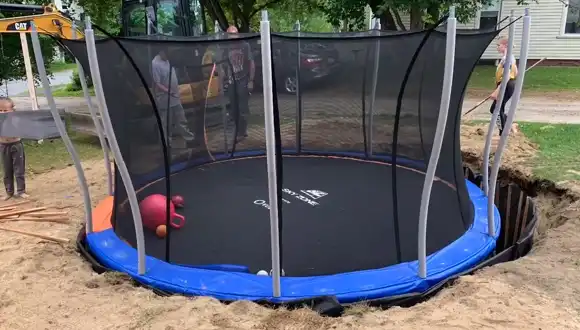
If you’ve been considering buying an inground trampoline, you may wonder how long it will last. The answer, of course, depends on several factors, including the quality of the trampoline and the way it’s used and maintained.
The frame pads on budget trampolines tend to last from six months to two years, while the frames on higher-quality trampolines may last ten to fifteen years or longer. Of course, even the best-quality trampoline will only last as long as it’s properly used and maintained.
For example, if the frame pads are not regularly inspected and replaced as needed, they will degrade more quickly and must be replaced more often. Similarly, if the trampoline is not used according to the manufacturer’s instructions (for example, if too many people are allowed on it at once), it is likely to break down sooner than it would otherwise.
How to Care for an Inground Trampoline for Longevity?
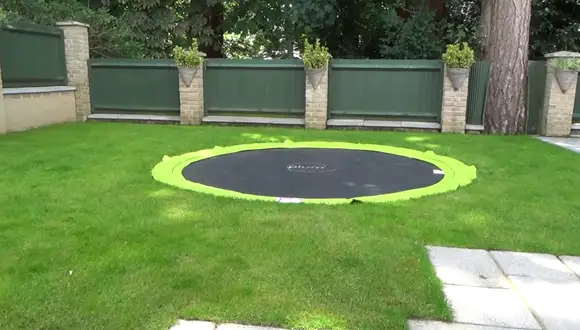
When you install an inground trampoline, you want to ensure that you do everything possible to protect your investment. The following tips will help keep your inground trampoline in top condition for many years of enjoyment:
Inspect the Jump Pad and Frame
You should regularly check the jump pad and frame for wear and tear. The jump pad is the part of the trampoline that you jump on and is very susceptible to damage. The frame is what supports the jump pad, and it’s also vulnerable to wear and tear.
If you notice any rips or tears in either the jump pad or frame, it’s vital to have them repaired as soon as possible. Taking good care of your inground trampoline will help ensure that it provides years of fun for your family.
Try to Use a Cover
One of the best ways to protect your trampoline is to use a cover. A cover helps to protect the trampoline from the elements, keeping it clean and dry when it’s not in use. It also helps to prevent leaves and other debris from clogging up the springs and mat.
Trampoline covers come in various sizes and styles to fit nearly any trampoline, and they help to protect the jumping surface from sun, rain, snow, and debris.
Inspect All the Parts
To get the most out of your trampoline, it is important to care for it properly. That means annual parts inspections, including the frame, mat, springs, and safety pads. This will ensure that your trampoline is in good condition and safe to use.
Inspecting the frame regularly will help to identify any problems, such as rust or other damage. Ensure the trampoline mat is free of tears and holes that could cause injuries. The springs should be checked for signs of wear, and the safety pads should be replaced if they are ripped or torn.
Are In-ground Trampolines Safe for All Kids?
In-ground trampolines are gaining in popularity, but there is some debate about whether or not they are safe for all age groups. Proponents of inground trampolines argue that they are safer than above-ground trampolines because they are closer to the ground and have softer landing surfaces.
Also, in-ground trampolines can be surrounded by padding or nets to reduce the risk of injury further. But, critics argue that in-ground trampolines are still dangerous because they can be hidden hazards for young children who might fall into them.
Ultimately, the decision about whether or not to install an in-ground trampoline should be made after carefully considering all the risks and benefits.
Recommended Article To Read:
